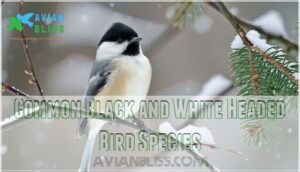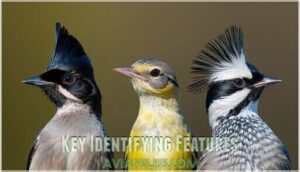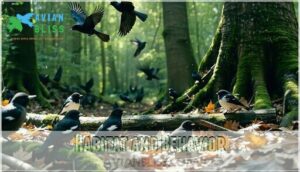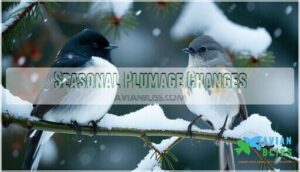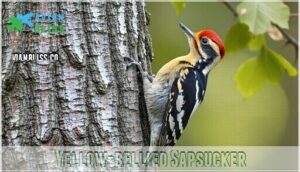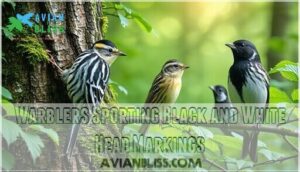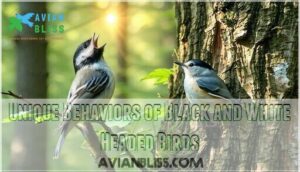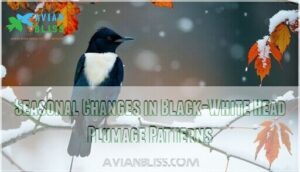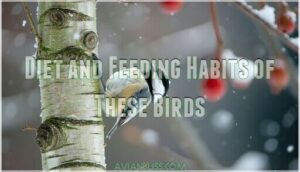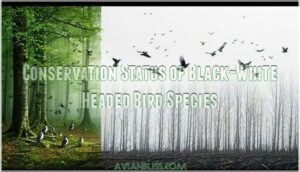This site is supported by our readers. We may earn a commission, at no cost to you, if you purchase through links.
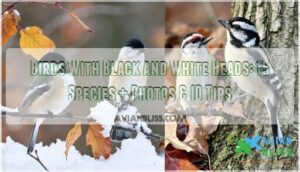
The Black-capped Chickadee sports a distinctive black cap and white cheeks, while White-crowned Sparrows display bold black and white stripes like racing stripes across their heads.
Mountain and Carolina Chickadees share similar patterns but prefer different regions.
Woodpeckers like the Hairy and Downy varieties showcase striking black and white head markings, perfect for identification.
Warblers such as the Black-and-white Warbler add acrobatic flair with their tree-climbing antics.
Each species has evolved these contrasting patterns for communication and mate recognition, making identification surprisingly straightforward once you know their telltale features.
Table Of Contents
- Key Takeaways
- Common Black and White Headed Bird Species
- Identifying Features of Black and White Headed Birds
- Woodpeckers With Black and White Head Patterns
- Habitat and Distribution of Black-White Headed Birds
- Warblers Sporting Black and White Head Markings
- Unique Behaviors of Black and White Headed Birds
- Seasonal Changes in Black-White Head Plumage Patterns
- Diet and Feeding Habits of These Birds
- Conservation Status of Black-White Headed Bird Species
- Attracting Black and White Headed Birds to Gardens
- Frequently Asked Questions (FAQs)
- What birds have black and white striped heads?
- Do birds have black heads?
- What is a black and white bird?
- What does a black gullet bird look like?
- How do you identify a black and white bird?
- How many black and white birds are there?
- What kind of bird is black with a white head?
- How rare is a White-crowned Sparrow?
- What small bird has a striped black and white head?
- How to attract White-crowned Sparrows?
- Conclusion
Key Takeaways
- You’ll easily identify black and white headed birds by focusing on three key features: cap size and stripe patterns, beak shape (thin for insect-eaters vs. thick for seed-crackers), and body size compared to common birds like robins.
- You can attract these striking birds to your backyard by setting up feeders with sunflower seeds and suet, providing fresh water sources, and planting native trees like oak and maple that offer natural food and shelter.
- You’ll notice dramatic seasonal changes in their plumage patterns – bold breeding colors in spring for mate attraction transform into muted winter tones for camouflage and survival.
- You’ll find these birds across diverse North American habitats from dense forests to city parks, with species like Black-capped Chickadees thriving in mixed woodlands while Mountain Chickadees prefer higher elevations.
Common Black and White Headed Bird Species
You’ll find several common bird species with striking black and white head patterns visiting your backyard feeders and local parks throughout North America.
These familiar birds include the Black-capped Chickadee, White-crowned Sparrow, White-throated Sparrow, Mountain Chickadee, and Carolina Chickadee, each displaying unique head markings that make identification straightforward once you know what to look for. Black and white head patterns
Black-capped Chickadee
You’ll instantly recognize the black-capped chickadee by its striking black cap and bib contrasting with bright white cheeks.
These fearless acrobats at feeders make bird identification simple for beginners.
These black and white birds measure just 5.9 inches but pack impressive chickadee intelligence, remembering thousands of seed hiding spots.
Their complex vocalizations and social hierarchy help them survive harsh winters.
Backyard attraction is easy—they’re fearless acrobats at feeders, making bird identification simple for beginners.
To attract them, consider a specialized chickadee feeder.
White-crowned Sparrow
The White-crowned Sparrow’s distinctive black-and-white striped crown makes bird identification straightforward among black and white birds.
These remarkable travelers showcase impressive migration patterns, covering up to 2,600 miles during seasonal journeys.
You’ll recognize this species by three key features:
- Bold crown stripes – alternating black and white markings create their signature look
- Ground-feeding behavior – they prefer foraging on the ground rather than in trees
- Sweet vocalizations – their melodic whistles help distinguish them from similar birds with white markings
Plumage variations exist between subspecies identification, though products aid identification, and conservation threats continue affecting populations.
White-throated Sparrow
You’ll recognize this woodland songbird by its crisp white throat patch and distinctive head stripes.
The White-throated Sparrow’s famous "Old Sam Peabody-Peabody" song shows fascinating Regional Differences across North America, with some populations shifting to simpler two-note endings.
Female Plumage appears duller than males, while Song Variations help distinguish breeding territories.
They also contribute to plant seed dispersal.
Key identification features include:
- Bright white throat contrasting with gray-brown chest
- Yellow spots between bill and eyes (lores)
- Black and white striped crown pattern
- Winter Flocks gather in southern forests and backyards
- Conservation Needs focus on protecting breeding habitat in Canadian boreal forests
Mountain Chickadee
High in North America’s coniferous forests, you’ll spot the Mountain Chickadee with its signature white eyebrow stripe cutting through its black cap.
These black and white birds thrive in habitat variations from ponderosa pines to alpine firs.
Their complex vocalizations include a distinctive "chick-a-dee-dee" call that varies by flock.
During breeding habits season, pairs excavate nest cavities in dead wood.
Watch for their acrobatic foraging as they hang upside-down searching for insects and cached seeds.
Carolina Chickadee
Carolina Chickadees (Poecile carolinensis) thrive from Delaware to Texas, sporting their signature black cap and bib with bright white cheeks.
You’ll spot these backyard visitors year-round at feeders, munching insects and seeds. Their gray back completes their classic look.
Listen for their cheerful "chick-a-dee-dee" calls as they explore nest boxes and tree cavities.
These intelligent birds cache food for winter, demonstrating remarkable memory skills that help them survive harsh seasons.
Identifying Features of Black and White Headed Birds
When you’re trying to identify black and white headed birds, you’ll need to focus on specific features like cap size, stripe patterns, and beak shape.
These distinctive markings, combined with body size and habitat preferences, will help you distinguish between similar species like chickadees, sparrows, and woodpeckers.
Key Identifying Features
Identifying black and white birds becomes straightforward when you know what to look for. These distinctive bird markings help you separate one species from another with confidence.
Focus on these three key identification features:
- Size comparison: Compare the bird to common objects like a robin or your fist for accurate sizing
- Beak shape: Notice whether it’s needle-thin like warblers or thick like seed-crackers
- Plumage patterns: Look for unique arrangements – striped heads, solid caps, or checkered wings
Vocalizations also provide clues, as each species has signature calls. Watch their flight style too – some flutter while others glide smoothly through trees.
Habitat and Behavior
Understanding bird habitat and bird behavior helps you spot birds with black and white heads more easily.
These black and white birds show distinct Nesting Preferences, from tree cavities to ground cups.
Their Social Structures vary—chickadees flock together while woodpeckers prefer solitude.
Foraging Strategies differ too: warblers pick insects from bark, while sparrows scratch ground debris.
Territoriality peaks during breeding season.
Many display striking black and white plumage.
Seasonal Plumage Changes
Throughout the year, your favorite black and white birds undergo dramatic transformations that’ll leave you doing double-takes at your feeder.
Nature’s feathered magicians swap their striking costumes with the seasons, creating backyard surprises year-round.
These plumage variations aren’t just nature’s vanity project – they’re survival strategies that help birds adapt to changing environments and social needs.
Breeding Plumage emerges in spring when black headed birds sport their boldest patterns to attract mates. Winter Colors turn subdued as Camouflage Changes help birds blend with bare branches and snow. Molting Patterns vary dramatically between species, with some white headed birds changing gradually while others molt completely.
Here’s what you’ll notice throughout the seasons:
- Spring breeding season brings vibrant contrasts and sharp definition to black and white markings
- Summer molt produces patchy, mixed plumage as old feathers fall out
- Winter camouflage creates muted tones perfect for survival
Woodpeckers With Black and White Head Patterns
You’ll find several woodpecker species display striking black and white head patterns that make identification straightforward once you know what to look for.
These birds range from the tiny Downy Woodpecker with its distinctive striped head to the massive Pileated Woodpecker with its bold black and white facial markings.
Hairy Woodpecker
Spotting a Hairy Woodpecker feels like discovering nature’s perfect carpenter.
This robin-sized black and white bird dominates North America’s forests with its distinctive long bill and bold head stripes.
Males flash red patches that distinguish them from similar Downy Woodpeckers.
You’ll hear their sharp "peek" calls echoing through mature woodlands where they nest in tree cavities, foraging for beetle larvae and ants beneath bark while drumming rhythmic territorial songs.
To further assist with identification, consider specialized Hairy Woodpecker resources.
Yellow-bellied Sapsucker
Looking through forest edges in spring, you’ll recognize the yellow-bellied sapsucker by its distinctive black-and-white head pattern and robin-sized frame.
These birds of North America create telltale damage through their unique sapsucker behavior. Their drumming pattern is an irregular tap-tap, tap-tap-tap, tap, tap-tap-tap.
Sapsucker identification involves these key features:
- Males display bright red foreheads and throats
- Both sexes show bold white wing stripes
- Their sapsucker diet creates neat rows of holes in bark
Downy Woodpecker
You’ll recognize the Downy Woodpecker as North America’s smallest woodpecker, measuring just 5.5 inches with distinctive black and white head stripes.
Males sport a red patch on their crown, while females lack this marking.
These acrobatic birds with black and white heads frequent backyards and woodland edges.
| Feature | Details |
|---|---|
| Downy size | 5.5 inches long, 0.7 oz |
| Male markings | Red crown patch (females lack) |
| Habitat range | Woodlands, parks, backyards |
| Feeding habits | Insects, suet, tree sap |
Pileated Woodpecker
When you encounter North America’s largest woodpecker, the Pileated Woodpecker commands attention with its crow-like size and distinctive red crest.
These impressive birds with black and white heads create their signature rectangular holes while hunting carpenter ants in mature forests.
Here’s what makes Pileated Woodpecker identification straightforward:
- Size: Nearly crow-sized at 16-19 inches tall
- Habitat preference: Dense, mature deciduous and mixed forests
- Drumming behavior: Loud, resonant drumming echoes through woods
- Diet specifics: Primarily carpenter ants and wood-boring beetle larvae
Habitat and Distribution of Black-White Headed Birds
Black and white headed birds call diverse landscapes home across North America, from dense woodlands to bustling city parks. These adaptable species have carved out niches in nearly every habitat you can imagine.
Forest Habitats support the highest diversity of these striking birds. Black-capped Chickadees flourish in mixed deciduous forests, while White-headed Woodpeckers prefer recently burned coniferous stands. Regional Variations show fascinating patterns – Mountain Chickadees stick to higher elevations, whereas Carolina Chickadees dominate southeastern lowlands.
Urban Distribution has expanded substantially as cities develop green spaces. Many species now thrive in suburban yards and parks. Migration Patterns shift dramatically with seasons, bringing different species to your area at various times.
Climate Impact influences their ranges more than ever. Here’s what drives their distribution:
- Temperature tolerance shapes northern boundaries
- Food availability determines winter survival
- Nesting site requirements limit breeding areas
- Water sources anchor year-round populations
Understanding bird range helps predict when you’ll spot these beauties in your neighborhood. Many species use plumage for communication.
Warblers Sporting Black and White Head Markings
You’ll find that warblers with black and white head markings are among the most striking songbirds in North America, featuring bold striped patterns that make identification easier during spring migration.
These small, active birds include the Black-and-white Warbler with its zebra-like stripes, the male Blackpoll Warbler’s distinctive black cap, and the Black-throated Gray Warbler’s intricate facial patterns.
Black-and-white Warbler
Striped Plumage makes the Blackandwhite Warbler unmistakable among black and white birds. You’ll recognize this zebra-patterned warbler by its distinctive Curved Beak and bark-creeping behavior.
Unlike typical warblers, it forages like a nuthatch, spiraling up tree trunks searching for insects. Bird identification becomes easier when you spot their unique feeding style.
Their Insect Diet includes beetles, moths, and caterpillars hidden in bark crevices.
Nesting Habits involve ground-level cup nests at tree bases. Habitat Needs include mature forests with large trees.
These birds with black and white heads arrive early in spring, making bird watching rewarding for patient observers.
Blackpoll Warbler
The Blackpoll Warbler transforms dramatically during breeding season, showcasing its distinctive black cap and white cheeks that make it a standout among black and white birds.
You’ll spot these incredible migrants during their epic journeys between boreal forests and South America.
Their breeding plumage creates striking contrast patterns that help with bird identification.
- Migration patterns include 72-hour non-stop flights over the Atlantic Ocean
- Insect diet focuses on caterpillars, beetles, and flying insects during breeding
- Habitat loss threatens their boreal forest nesting grounds across Canada
- Conservation efforts monitor population declines through citizen science bird watching programs
Black-throated Gray Warbler
You’ll recognize the Black-throated Gray Warbler by its distinctive facial patches and bold plumage details.
These black and white birds sport striking head stripes that make bird identification straightforward.
Listen for their buzzy vocalizations—"zeedle zeedle zeet-chee"—echoing through western pines.
Watch their active foraging habits as they hop through lower branches hunting insects.
Their nest construction occurs in dense shrubs, creating secure homes for raising young.
Unique Behaviors of Black and White Headed Birds
When observing birds with black and white heads, you’ll discover fascinating behaviors that set them apart from other species.
These bird behavior studies reveal complex social hierarchies and intricate foraging strategies that help them thrive.
Birds with black markings display remarkable adaptations:
- Vocalizations – Black-capped Chickadees use over 15 different calls for communication
- Predator evasion – White-breasted Nuthatches walk headfirst down trees to spot threats
- Bird territoriality – Black-and-white Warblers defend specific foraging zones on tree trunks
Their mating rituals and bird foraging techniques showcase nature’s ingenuity perfectly.
Seasonal Changes in Black-White Head Plumage Patterns
Nature’s calendar dictates stunning transformations in birds with black and white heads throughout the year.
You’ll witness dramatic molting patterns as these feathered performers swap their costumes with the seasons.
Breeding plumage emerges in spring when males need to catch a mate’s eye, showcasing their boldest black and white plumage combinations.
Winter camouflage tells a different story.
Common loons trade their striking checkered backs for subdued gray tones, while ptarmigans become nearly pure white to blend with snow.
These bird coloration changes aren’t random—they’re survival strategies perfected over millions of years.
Watch for these seasonal shifts:
- Age differences create unique patterns, with juveniles often displaying muted versions of adult bird patterns
- Regional variation affects timing, with northern populations molting earlier than southern ones
- Bird feathers replace themselves systematically, starting around the bill area
- Molting typically begins in late September or early October across most species
These transformations reveal nature’s incredible adaptability in action.
Diet and Feeding Habits of These Birds
Discovering the dining preferences of black and white birds reveals fascinating patterns that’ll change how you view your backyard visitors.
These species employ diverse foraging techniques – chickadees hang upside down to reach insects, while woodpeckers use their specialized bird beaks to excavate beetle larvae from tree bark.
Seasonal diet shifts dramatically throughout the year.
Spring and summer bring protein-rich insects essential for breeding and raising chicks.
You’ll spot them hunting caterpillars, beetles, and spiders to meet their nutritional needs.
Winter transforms them into seed specialists, cracking sunflower seeds at backyard feeders with precision.
Prey selection varies by species – nuthatches prefer nuts and seeds, while warblers focus on small insects.
Some practice food storage, like chickadees caching seeds in tree bark crevices for leaner times.
Understanding bird feeding habits helps you choose appropriate foods when attracting these striking black and white birds to your garden.
Conservation Status of Black-White Headed Bird Species
Bird conservation presents a mixed picture for black and white species across North America. While some populations remain stable, others face significant challenges that demand our attention.
Population Trends reveal concerning patterns. The Black-and-white Warbler shows gradual decline over fifty years, while Black Skimmers earn Threatened Species status in Florida. However, species like Black-billed Magpies maintain stable numbers with Least Concern classifications.
Habitat Loss emerges as the primary threat. Deforestation affects multiple warbler species, while coastal development impacts Black Skimmers’ nesting sites. Climate Change compounds these problems by altering migration patterns and food availability. The coloration of these birds provides camouflage and adaptation essential for survival.
Here’s what’s happening to our feathered friends:
- Breeding grounds shrink as forests disappear for development
- Nesting sites vanish along coastlines and wetlands
- Food sources shift as insect populations change with temperature
Conservation Efforts show promise through protected reserves like Ecuador’s Buenaventura Reserve. Legal protections under the Migratory Bird Treaty Act provide additional safeguards. These bird conservation initiatives focus on habitat preservation and population monitoring to guarantee black and white birds continue thriving in their natural environments.
Attracting Black and White Headed Birds to Gardens
Bird feeders filled with sunflower seeds and suet create an irresistible buffet for black and white birds like chickadees and nuthatches.
Add water sources such as birdbaths to complete their needs. Native plants like oak and maple provide natural food while offering shelter options.
Install nesting boxes filled with sawdust to give chickadees cozy homes. These backyard black and white birds with distinctive black and white heads will reward your efforts by turning your garden into a lively bird attraction hotspot.
Regularly cleaning feeders helps prevent disease spread among birds.
Frequently Asked Questions (FAQs)
What birds have black and white striped heads?
You’ll spot several feathered comedians sporting this dapper look.
White-crowned Sparrows, White-throated Sparrows, and Mountain Chickadees rock bold black-and-white striped heads that’ll make you do a double-take during your backyard birdwatching adventures, with their dapper appearance being a notable feature.
Do birds have black heads?
Yes, you’ll find many bird species sport solid black heads.
Black-capped chickadees, Carolina chickadees, and dark-eyed juncos showcase this striking feature.
These bold head markings help with species identification and often indicate gender differences in various bird families.
What is a black and white bird?
Picture a zebra with wings soaring overhead.
You’ll spot various black and white birds like chickadees with their distinctive caps, elegant woodpeckers sporting striped patterns, or striking magpies flashing iridescent tails across your backyard.
What does a black gullet bird look like?
You’ll notice a black gullet bird has a distinctive dark throat patch that contrasts sharply with lighter plumage.
This marking creates a striking bib-like appearance, often paired with white cheeks and varying body colors.
How do you identify a black and white bird?
Like detective work, identifying black and white birds requires sharp observation.
You’ll examine head patterns, body size, and beak shape.
Look for distinctive markings like caps, stripes, or patches that reveal each species’ unique identity.
How many black and white birds are there?
You’ll find dozens of black and white bird species across North America.
From tiny chickadees to large magpies, there’s no exact count since new species get discovered and classifications change regularly.
What kind of bird is black with a white head?
You’re likely spotting a White-headed Woodpecker, the only North American bird with a completely black body and white head.
These unique birds inhabit pine forests in the western United States, where they expertly extract seeds from cones.
How rare is a White-crowned Sparrow?
White-crowned Sparrows aren’t rare at all.
You’ll spot them across North America, from Alaska to Central America.
They’re common year-round east of the Rockies and along the west coast during migration seasons.
What small bird has a striped black and white head?
Surprisingly, you’ve got several options!
White-crowned Sparrows sport bold black and white head stripes, while White-throated Sparrows show similar patterns.
Mountain Chickadees and Black-capped Chickadees also display distinctive striped heads you’ll easily recognize.
How to attract White-crowned Sparrows?
Attract these beautiful sparrows by offering mixed seeds, millet, and sunflower seeds in ground feeders.
Plant native grasses and shrubs for nesting. Provide fresh water sources and maintain brushy areas where they’ll feel safe foraging naturally.
Conclusion
Spotting birds with black and white heads becomes second nature once you’ve mastered their key features.
You’ll never mistake a Black-capped Chickadee’s cap for a White-crowned Sparrow’s stripes again.
These distinctive markings serve as nature’s perfect identification system, making birdwatching surprisingly straightforward.
Whether you’re observing woodpeckers at your feeder or tracking warblers through forest canopies, you’re now equipped with the knowledge to confidently identify these striking species and appreciate their unique adaptations.

